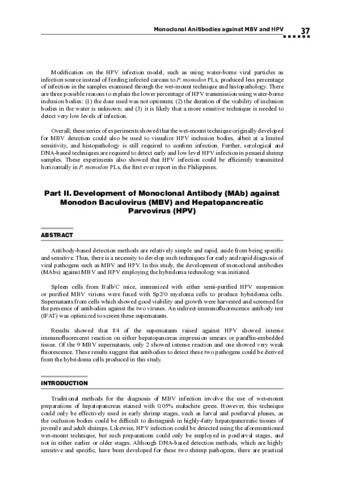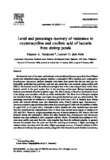Development of monoclonal antibody (MAb) against monodon baculovirus (MBV) and hepatopancreatic parvovirus (HPV)
- Global styles
- MLA
- Vancouver
- Elsevier - Harvard
- APA
- Help

Date
2005-03Page views
1,930ASFA keyword
AGROVOC keyword
Taxonomic term
Metadata
Show full item record
Share
Abstract
Antibody-based detection methods are relatively simple and rapid, aside from being specific and sensitive. Thus, there is a necessity to develop such techniques for early and rapid diagnosis of viral pathogens such as MBV and HPV. In this study, the development of monoclonal antibodies (MAbs) against MBV and HPV employing the hybridoma technology was initiated.
Spleen cells from Balb/C mice, immunized with either semi-purified HPV suspension or purified MBV virions were fused with Sp2/0 myeloma cells to produce hybridoma cells. Supernatants from cells which showed good viability and growth were harvested and screened for the presence of antibodies against the two viruses. An indirect immunofluorescence antibody test (IFAT) was optimized to screen these supernatants.
Results showed that 84 of the supernatants raised against HPV showed intense immunofluorescent reaction on either hepatopancreas impression smears or paraffin-embedded tissue. Of the 9 MBV supernatants, only 2 showed intense reaction and one showed very weak fluorescence. These results suggest that antibodies to detect these two pathogens could be derived from the hybridoma cells produced in this study.
Suggested Citation
Catap, E. S., & de la Peña, L. D. (2005). Development of monoclonal antibody (MAb) against monodon baculovirus (MBV) and hepatopancreatic parvovirus (HPV). In K. Nagasawa (Ed.), Recent Advances in Diagnosis and Prevention of Fish and Shrimp Diseases in Southeast Asia (pp. 37–44). Tigbauan, Iloilo, Philippines: Aquaculture Department, Southeast Asian Fisheries Development Center.
Type
Book chapterISBN
9718511732
Related items
Showing items related by title, author, creator and subject.
-
Development of shrimp (Penaeus monodon) cell culture in vitro
Kasornchandra, Jiraporn; Khongpradit, R. (Aquaculture Department, Southeast Asian Fisheries Development Center, 2005-03)Primary shrimp cell cultures were successfully developed from lymphoid organ of black tiger shrimp (Penaeus monodon) in double-strength Leibovitz’s L-15 medium supplemented with 15% fetal bovine serum, 1% glucose, 15% ... -
Prevalence of yellow head virus in cultured black tiger shrimp (Penaeus monodon Fabricius) from selected shrimp farms in the Philippines
Natividad, Karlo Dante T.; Magbanua, Fe O.; Migo, Veronica P.; Alfafara, Catalino G.; Albaladejo, Juan D.; Nadala, Jr., Elpidio Cesar B.; Loh, Philip C.; Tapay, Lourdes M. (Fish Health Section, Asian Fisheries Society, 2002)The prevalence and geographic distribution of Yellow head virus (YHV) in cultured Penaeus monodon in the Philippines was documented by Western blot assay. Fifty-three out of 219 samples (24.2%) were found to be positive ... -
Level and percentage recovery of resistance to oxytetracycline and oxolinic acid of bacteria from shrimp ponds
The bacterial level of the water, sediment and cultured shrimp (Penaeus monodon) from different ponds were determined using a general medium, a presumptive Vibrio medium and a presumptive Pseudomonas–Aeromonas medium. ...

 AQD Access
AQD Access





